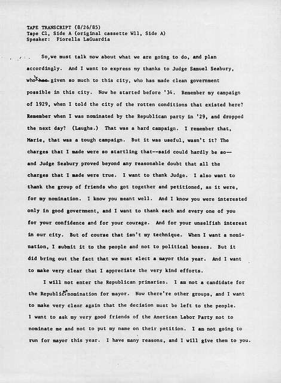Style, Delivery, & Audience Engagement
10 Engaging Your Audience
Learning Objectives
- Compare and contrast four common modes of delivery
- Define communication apprehension and identify strategies to manage it
- Characterize delivery as an individual skill that is situational and constantly evolving
- Strategize best practices for rehearsal
When most people think about public speaking, they probably focus mostly on delivery and memory. Delivery, as you’ll learn more about in the next chapter, is how a speaker physically conveys words and ideas, both vocally and nonverbally, to the audience. When a speaker uses an electronic medium of communication, delivery also regards the speaker’s use of televisual elements, such as the camera, lighting, and background, to communicate. Memory is how a speaker stores and recalls the information shared in a speech, such as whether and how much they depend on notes.
Delivery and memory are two of the most visible elements of public speaking. Consequently, it’s easy to equate speaking success with animated gestures, energetic volume, and sustained eye contact. These elements do make a difference, and rhetoric teachers have developed principles and practices to use them effectively.
However, delivery and memory should be placed alongside the many other components of public speaking. Indeed, our positioning of delivery and memory in this book—in the middle—underscores their roles as two of many elements of public speaking rather than a primary focus of attention. In other words, don’t place so much focus on your delivery that you neglect your research, audience adaptation, organization, or verbal style.
At the same time, cultivating skills in delivery and memory is very important. If you have ever listened to a speaker say “like” and “you know” after every sentence, or watched them stare at their notes the entire time, or seen them constantly move in and out of the screen’s frame, you understand why. This chapter begins with the goals of speech delivery, followed by a focus on memory and four associated modes of delivery. We also discuss the rehearsal process before concluding with several principles of delivery to keep in mind as you prepare and practice your speech.
Delivery Goals
The ultimate objective of speech delivery is to communicate with your direct audience effectively and clearly. Recall we defined the direct audience in chapter 2 as the people who are exposed to and attend to your speech. To that end, effective delivery should achieve three goals: engage this audience, enhance your ideas, and strengthen your credibility.
First, well-executed delivery helps your audience feel connected to you as a speaker and invested in your speech topic. Ineffective delivery may result in disengaging the audience instead.
Second, delivery also supports your speech content without becoming the focus of attention. Poor delivery can distract from your ideas and instead draw attention to your repetitive use of gestures or excessively fast rate of talking.
Finally, delivery aids your credibility with the audience, or ethos. As discussed in previous chapters, ethos refers to an audience’s perceptions of a speaker’s public character or persona. Effective delivery can bolster an audience’s sense of your goodwill, trustworthiness, competence, and dynamism, but poor delivery can undermine their perception of these qualities. Next we discuss four modes of delivery you can use to achieve these goals.
Memory and Modes of Delivery
Again, memory is how one stores and recalls the information that is shared in a speech. That means delivery and memory go hand in hand. Beginning speakers often find that their delivery improves when they increase their ability to remember their material. As with many aspects of public speaking, how we use our memory is dependent on the expectations and constraints of the speaking situation.
Public speaking scholars commonly recognize four modes of delivery, methods by which a speaker delivers their information. Each approach has its merits in particular situations. We begin discussion of modes of delivery by considering an extemporaneous delivery and then address impromptu, memorized, and manuscript deliveries in turn.
Extemporaneous Delivery
In an extemporaneous delivery, a speaker uses trimmed-down notes to recall the speech’s structure, key ideas, and any direct quotations or source citations. We say “trimmed down” because the notes only include the outline structure and prompting words and phrases; they do not include every word you plan to say (unlike a preparation outline). We call these notes a presentation outline and offer fuller instructions in chapter 8.
Because you cannot rely on your notes for exact wording, an extemporaneous delivery demands a sense of spontaneity as you choose most of your language in the moment. You may want to memorize a few ideas with more precision, such as the introduction (including your thesis and preview) and conclusion to help you begin and end the speech smoothly. With the exception of these elements, however, your delivery will vary each time you practice or give the speech. That keeps the speech fresh.
An extemporaneous delivery enables speakers to maintain a more conversational and energetic delivery while connecting with direct audience members. You are less tied to your notes, which allows you to be present in the situation and potentially make eye contact with the audience more easily. The flexibility offered by extemporaneous speaking also allows you to adjust to audience feedback, be that an unexpected audience reaction, a question posed during the speech, or when you detect the need to add or remove material based on audience feedback.

Extemporaneous delivery particularly suits public settings that discuss issues of community importance. In such situations, elements like setting, audience, and the time available for presentation can change without advanced notice. Relatedly, comments made by other participants before your chance to speak may influence what you plan to say or how you say it. This mode of delivery allows you to alter your remarks in the moment. Thus, extemporaneous speaking capitalizes on your advanced preparation while enabling you to respond to the needs of a given situation as they arise.
Box 10.1 Using an Extemporaneous Delivery to Quickly Adapt to the Situation
What would you do if you found out, moments before giving a speech, that you had half the time to speak than you had anticipated? Could you make cuts within seconds? Would your speaking notes easily accommodate those cuts?
Each of your textbook authors has been invited to speak in public settings. In one case, one of us was asked to deliver a twenty-minute presentation at a specific time. Upon arrival, however, she discovered the event was running late and the audience was growing tired. The person running the event told her she’d have ten minutes before the audience had to leave. She had to cut her speech in half to only the most salient points.
Fortunately, she had planned to speak extemporaneously, and her speaking notes consisted of a trimmed-down outline of keywords. That made it fairly easy to make significant adjustments on the fly. She marked out one main point and several subpoints, and she was ready to go. The audience likely never knew how drastically she changed her plan because of the flexibility an extemporaneous delivery provided her.
Impromptu Delivery
You have probably heard of the mode of delivery frequently called impromptu speaking. In an impromptu delivery, you rely on instant recall because it refers to a situation in which you speak publicly without advance preparation or warning. Your delivery is integrally linked to what you can recall and articulate about a topic on the spot.
This form of speaking comes with a rush of adrenaline as you either are thrust unexpectedly into a speaking situation or feel compelled to suddenly, voluntarily enter a discussion of an issue. As such, it is a reactionary form of speaking, often characterized by high energy and spontaneity while featuring less polish and being more prone to vocal fillers.

Due to the lack of preparation, you may feel more anxiety and pressure with impromptu speaking. Almost inevitably when looking back later, you will think of things you wish you had said. Impromptu speaking challenges even seasoned speakers.
While impromptu speaking prevents formal preparation, you can adopt four strategies to speak more effectively: Take a breath, quickly organize your thoughts, mentally prepare, and jot down notes.
First, take a breath! While you will not have time to develop a speech, you can take a moment to collect your thoughts. Write down two or three keywords, each of which might represent a central point or example you want to mention.
Second, remember the organizational principles you learned in chapter 7 because they are helpful even in impromptu speaking. Begin your remarks by stating your central point, perspective, or position. Follow that with a short series of brief supporting ideas, probably no more than two or three. You might number the ideas or offset them with transitions to keep the points distinct. Where possible, offer detail in support of your claim in the form of specific examples or illustrations. When you conclude, offer a summary of what you have said.
Third, be prepared. That undoubtedly sounds paradoxical, but there are ways you can mentally prepare for the prospect of impromptu speaking. Most importantly, practice ethical listening as discussed in chapter 2. By being present and engaged in a communication setting, listening actively, and being mentally alert, you will be better prepared to speak if desired or called on.
Lastly, have a way of taking notes (pen and paper, tablet, etc.) so you can jot down ideas during the discussion. This too will spark your thinking and allow you to formulate a response or question to contribute to the ongoing dialogue.
Memorized Delivery
As its title suggests, in memorized delivery you memorize the speech word for word with the intent of precisely recalling and delivering its content without the aid of notes or a manuscript. This mode of delivery emphasizes your memory, requiring extensive practice to recall not only ideas but the exact words prepared for the presentation.
As you can imagine, effective memorized speaking is difficult, particularly for lengthy presentations. It also comes with substantial risks, including “blanking” on what you plan to say, needing to rebound from a lapse in memory, and finding the flexibility necessary to adapt to a challenging situation or adverse audience feedback.
Box 10.2 Disadvantages of a Memorized Delivery
 Have you ever tried to memorize a lengthy text? One of your textbook authors competed in their high school’s speech and debate club. They researched, wrote, and frequently delivered a ten-minute informative speech completely from memory, with no notes! That feat was impressive when they succeeded. On one occasion, however, they suddenly lost their place about four minutes into the speech. Instead of picking up where they stopped, they had to start the speech over—from the very beginning. That was the only way they could recite it fully. Talk about embarrassing!
Have you ever tried to memorize a lengthy text? One of your textbook authors competed in their high school’s speech and debate club. They researched, wrote, and frequently delivered a ten-minute informative speech completely from memory, with no notes! That feat was impressive when they succeeded. On one occasion, however, they suddenly lost their place about four minutes into the speech. Instead of picking up where they stopped, they had to start the speech over—from the very beginning. That was the only way they could recite it fully. Talk about embarrassing!
A final concern for memorized speaking is the adoption of a mechanical delivery and a vacant or distant look—one that lessens engagement with the audience—that can result from the strain of recalling the words. This sort of “canned” presentation—one that is fully prepared in advance—can result in the speaker losing touch with the moment during the presentation.
Memorized speaking should be used sparingly, though it can be valuable in particular situations. Crises, for instance, can call for specific, prepared language that informs or comforts a community. A memorized delivery in these cases allows the speaker to visually connect with listeners instead of looking down at a manuscript. It also prevents the speaker from inadvertently saying something that prompts additional uncertainty or harm.

Speeches given routinely may also benefit from memorization, such as a university campus tour speech, because the guides can look where they are walking while still providing all the details each tour group seeks. If you deliver a memorized speech, allow plenty of time to commit the speech to memory and attempt to do at least one full rehearsal with a listener who can provide feedback on your vocal, nonverbal, and—if appropriate—televisual delivery.
Manuscript Delivery

Finally, in manuscript delivery, the speaker writes the entire address in advance and utilizes the text in delivering the speech. Depending on the technology available (e.g., a teleprompter, video conference), the use of a manuscript may not be readily apparent.
A skilled manuscript speaker achieves the goals of an effective delivery. That is, they engage the audience, enhance their ideas, and strengthen their credibility. Such success requires preparing your manuscript in ways that free you from monotonously reading your text.
Manuscript speaking is best suited to formal situations with a large direct audience. This includes formal platform speaking and some televised or recorded speeches with a large viewership. Manuscript speaking also aids occasions where precise wording matters and you have given particular attention to the artistry and style of the speech. Finally, manuscript speeches are common for lengthy addresses. They have the advantage of letting you know more precisely how long your speech will take to deliver.
Box 10.3 Amanda Gorman’s Manuscript Delivery

It takes real skill and practice to effectively deliver a manuscript speech, and it should not be envisioned as simply reading to the audience. Amanda Gorman’s presentation of her poem “The Hill We Climb” at President Biden’s 2021 inauguration ceremony offers a particularly strong example of a well-delivered manuscript presentation. She powerfully drew on such vocal and nonverbal delivery techniques as eye contact, gestures, rate, and the strategic use of intonation and pronunciation to enhance her recitation of the poem. Her delivery helped animate the poem’s artistry and sense of urgency, making her performance one of the most talked about moments from the inauguration.
Every mode of delivery offers both opportunities and constraints. We encourage you to make a thoughtful choice based on your speaking situation, audience, and personal comfort and strengths. Whatever mode of delivery you choose, you will likely experience some degree of nervousness and anxiety. We turn to that challenge next.
Box 10.4 Choosing a Mode of Delivery for Civic Engagement
Opportunities to speak in your community can greatly differ by audience, situation, location, medium, timing, occasion, and purpose. It’s important you choose a mode of delivery that best suits each opportunity, features your strengths as a speaker, and aids your purpose. The following are a few potential civic speaking engagements to help you reflect on available modes of delivery.
- Meeting or public event organized by a civic organization or group: An extemporaneous delivery is ideal if you are invited in advance to address the group, but you will need to rely on an impromptu approach if you are spontaneously asked or suddenly decide to comment. If you are speaking at an event where you will interact with the broader public, an impromptu delivery can provide you with maximum flexibility while keeping a few talking points in mind.
- Ceremonial gathering (dedication, celebration, memorial): For a large, formal ceremonial gathering, a manuscript or memorized delivery will enable you to carefully plan your comments for the occasion and do so with a thoughtful use of verbal style. Choosing between using a manuscript or memorizing your comments may depend on your personal preference and the audience’s expectations. If the gathering is a bit more casual, then an extemporaneous approach can give you more flexibility and informality in your delivery.
- Protest, march, or rally: If you are helping to lead a protest, march, or rally and plan to address attendees at a particular moment, a memorized delivery can ensure you communicate your message precisely while maintaining a visible connection with participants. An impromptu approach may be required if you are suddenly called on to address attendees.
- Publicity for a community event: An extemporaneous or manuscript delivery can work well to share specific information about an event, such as when invited as a guest on a local radio station or when recording a podcast.
We recommend playing with all 4 types of delivery (though extemporaneous is most common in public speaking). Once you identify what type of delivery style you’ll use in a speech, it’s time to rehearse.
Rehearsal
Rehearsal sounds like homework, we know. Rehearsing your speech, however, doesn’t just assist in increasing one’s speech grade. Rehearsing is your commitment to bettering your foundational communication skills for the long haul.
This might be a good place to dispel a few myths about public speaking that can influence perceptions of rehearsal:
Myth #1: You are either born a good public speaker or not. While someone may have certain characteristics that are attractive in our cultural understanding of public speaking, good rehearsal will create conditions for everyone to become better speakers.
Myth #2: Practice makes perfect. It is possible to practice incorrectly, so in that case, practice will make permanent, not perfect. There is a right way and a wrong way to practice a speech, musical instrument, or sport.
Myth #3: Public speaking is just reading what you wrote or reading and talking at the same time. For example: I (one of your authors) often hear envy over my public speaking abilities, but I certainly was not blessed with a universal speaking gene. Instead, I spent years doing debate, speech, and performance to practice writing arguments, responding to ideas, and crafting a public speaking persona. When I do presentations, I spend lots of time workshopping the speech “on my feet” to determine the best type of delivery, where to emphasize, when to move, while considering the entire scene that’s being created. Because I have practiced a lot, though, I am more confident about these decisions during the rehearsal process so I perform more consistently.
Have you found yourself using one of these myths? Sadly, we often rely on these myths to talk ourselves into believing that public speaking isn’t for us – never was and never will be.
You might also, for example, have attempted rehearsal in the past and thought, “How am I supposed to remember all these words and all these bodily movements at the same time?! It’s impossible!” It’s true: there’s a lot going on when you give a public speech, and focusing on the various aspects of memory and delivery requires a conscious effort. Think about the classic party trick of rubbing your belly and patting your head at the same time. In the first attempt, you may have struggled (like some of us!). With practice, though, you can find strategies that allow you to accomplish this task that, at first glance, was too much.
One major misconception about rehearsal is that it begins when your speech is completely written. Start rehearsing as soon as you can. Too often, speakers wait until the entire speech is complete – it’s been created, written, and is on paper. We recommend, however, embedding rehearsal workshops throughout your speech preparation. Why?
Rehearsal and workshopping will assist you in translating the written argument into verbal form. “How does this sound?” or “I think I know another example that would work well here.” Using rehearsal to workshop content allows you to listen to the sound of your argument out loud rather than reading on paper only.
Rehearsal, thus, is an ongoing process and part of your entire public speaking preparation. So, now what? What does a good rehearsal consist of?
Check the Space
We’ve been a broken record, we know, but we’ll say it again: think about the context – including the space that you’re speaking in. The space—and resources available within it—will influence your rehearsal because you’ll know the spatial opportunities and constraints. Let’s talk through some key questions that you should ask of the space.
Is there a lectern or podium? If so, should I use it? Many speaking spaces include a lectern or a podium. A

lectern is a small raised surface, usually with a slanted top, where a speaker can place notes during a speech. A podium is a raised platform or stage. Both the lectern and podium allow speakers stability while they present, and there’s the added bonus of having some place to rest your speaking notes.
However, even for experienced speakers, it is all too tempting to grip the edges of the lectern with both hands for security. You might even wish you could hide behind it. Remember, too, that opting to keep your hands at your sides will not be visible to your audience. Be aware of these temptations so you can manage them effectively and present yourself to your audience in a manner they will perceive as confident.
If you opt to use a lectern, your rehearsal should integrate a similar structure. As you rehearse, try stepping to the side or front of the lectern when speaking with free hands, only occasionally standing at the lectern to consult your notes. This will enhance your eye contact as well as free up your hands for gesturing.
What size is the space? If you are accustomed to being in a classroom of a certain size, you will need to make adjustments when speaking in a smaller or larger space.
A large auditorium can be intimidating. Most of us are used to sitting in the seats, not standing on the stage! Because it may be difficult to find a space that large while you rehearse, keep a few things in mind:
- Be aware that your voice is likely to echo, especially if far fewer people are in the space than it can hold, so you will want to speak more slowly than usual and make use of pauses to mark the ends of phrases and sentences. When you rehearse, slow down to account for the echo – listen to find ways to speak slowly while avoiding a robotic tone.
- Your facial expressions and gestures should be larger so that they are visible from farther away. If you are using presentation aids, they need to be large enough to be visible from the back of the auditorium. Of course, if you can get the audience to move to the front, that is the best situation, but it tends not to happen.
Limited space is not as disconcerting for most speakers as enormous space, and it has the advantage of minimizing the tendency to pace back and forth while you speak. A small space does call for more careful management of note cards and presentation aids, as your audience will be able to see up close what you are doing with your hands.
What about acoustics? The acoustics of your speaking space can often dictate an audience’s ability to hear and comprehend what you’re saying. If you are speaking outside, your voice is likely to carry and be less insulated than a theatre or small classroom. Remember, if your audience can’t hear you, they can’t experience your speech.
Check for a microphone: using a microphone will amplify your voice, so it is a good choice to increase your volume in an open or large acoustic space. Remember that a microphone may require that you slow down for the sound to carry. Check to see if it is handheld or can be clipped on. This may seem like a small difference, but it will affect your ability to move and gesture, so this small detail can make a larger impact on your delivery.
If you have never spoken with a microphone, ask to do a sound check and use that time to perform the first few lines of your speech to get an understanding of how your language will sound through a microphone in that space.
Workshop Strategies
Rehearsal means workshopping the embodiment of your speech. This is key because, as we’ve discussed, a speech is experienced differently by the audience than if they were reading it on a page. The sooner you begin and the sooner you become comfortable with rehearsal, the better your content will translate to the audience. To assist, let’s talk through some rehearsal strategies and best practices. Rather than a linear process, view these processes and strategies as circular or recursive – continue returning to each throughout rehearsal.
Conduct a self-assessment: We often hear, “oh no; I hate to listen to myself talk.” And we get it. It can feel strange to self-assess. While difficult and sometimes frustrating, it’s important to know what kind of speaker you are and what you’d like to improve. For example, are you often quiet and asked to speak up? Or, conversely, are you a loud talker whose booming voice fills up the room with ease?
These general questions about your communication style can begin giving insight into your strengths as a speaker, and the answers will be your focus areas during rehearsal. If you know that you’re a quick-talker, you’ll want to pay attention to pace and consciously integrate additional pauses. If you struggle with eye contact, asking a friend to rehearse with you can increase your comfort with engaging through eye contact.
However, you can only gain so much about your speaking strengths by investigating your general communication style. The best way to get a baseline understanding of your speaking style is to—you guessed it – watch yourself give a speech. Yes, this may feel awkward. But it’s worth it. When watching, we recommend that you identify any patterns in your approach to memory and delivery. After all, you’re looking for key areas to improve, so you want to hone in on things that seem to trip you up over and over.
With that in mind, we recommend two ways to approach conducting a self-assessment: start with general questions and move toward specific examples. Figure 10.1 guides you through this process.
|
Conducting a Self-Assessment |
|
As you watch yourself speak, take general notes about your enactment of memory and delivery as though you are an audience member.
|
| Figure 10.1 |
In conducting a self-assessment, your main goal is identifying opportunities for improvement and understanding your current strengths. The more comfortable you become with self-assessing, the less likely you’ll finish a speech and say, “I have no idea what I just did.”
Rehearse with all speaking materials: Rehearse with everything that you’ll speak with. Too often, speakers use their full outline (or even a full manuscript) when rehearsing and make a speaking outline right before standing up to speak. This makes effectiveness difficult, and understandably so. If you’re used to looking down at a full-length paper, using a notecard and a few keywords will feel radically strange and different in the moment.
Instead, rehearse with everything that you’ll speak with, including your speaking notes (check out Chapter 8 for assistance on creating a speaking outline). Speaking notes are your friend, and workshopping with your notes will create consistency and familiarity when you formally speak.
There are benefits beyond familiarity. You can, for example, create cues on your notes that communicate with your future speaking self. Do you have trouble with projection? Use a green highlighter on your speaking notes to remind yourself to “speak up!” The more you rehearse with that green mark, the more confidently and consciously you can work on projecting.
In addition to speaking notes, you should rehearse with any other materials that will be present – a presentational aid, a table, a chair, etc. If you’re using PowerPoint, you’ll want to rehearse with a clicker since you’ll likely have an additional device to hold. As you rehearse, ask: “do I need to hold this the entire time? Can I seamlessly place it on a table nearby? How long does the audience need to experience each slide?”
The more you integrate these materials into your rehearsal, the more seamless they’ll appear the day that you speak. Rather than be burdensome or awkward, they will be part of the speaking experience.
Start over and over and over: That’s right. Rehearsal is an over-and-over-and-over again process not a one-time-through ordeal. While a self-assessment is a key part of rehearsal, you may be unable to video yourself prior to a speech or presentation. In that case, starting over and workshopping repeatedly will be key.
As you begin workshopping, listen to the argumentative flow of your content: does this make sense? Can an idea be clarified? Does the transition connect the main points fully? How does the concluding thought leave the audience? Listening to the arguments will allow you to make choices regarding delivery and memory that will enhance that information.
Try it different ways. Listen. Try it another way. Listen. Do it again.
Slowly increase your stressors: If you have a higher level of anxiety around public speaking, there is no “bullet proof” mechanism to wipe that apprehension away. It can also be difficult to formally rehearse under the exact conditions that you’ll present in, particularly if a larger audience will be watching. That doesn’t mean, however, to give up on rehearsal. Instead, slowly increase the stressors that trigger your anxiety. For example: if the “live” audience component triggers your apprehension, rehearse your presentation in front of your roommate or friend. Having a trusted confidant can ease your anxiety but still account for a “live” audience member. After you’re comfortable (or more comfortable) speaking in front of your roommate, try again with a few classmates or peer group members.
Slowly increasing your stressors is a helpful strategy because, while we can’t eliminate all anxiety, rehearsing with minor stressors can remind your body (and your brain) that you’re capable of getting through through speech. It can also help you identify how your body responds to those stressors so that, in the future, you can make adjustments for the final presentation. For example, I (Meggie) didn’t realize that I would fill space with the filler “kind of” until after rehearsing with a trusted mentor. When you rehearse with live audience members, you get the benefit of their feedback to see what lands (and what doesn’t).
Successful rehearsal is a process of self-reflection and being comfortable critiquing your own presentational style. You can always (and we recommend) ask others for help – feedback will provide you with different perspectives. These techniques, however, should always happen before the day of your speech. We provide some day-of recommendations below.
The Day of Your Speech
Rehearsal continues until the moment you speak, including the day-of preparation. There are a few day-of rehearsal techniques that we recommend.
Warm up your voice. Have you ever begun talking and instead of a clear, articulate sentence, your voice sounded scratchy and awkward? Perhaps you had to clear your throat for your voice to return. That’s because your muscles weren’t warmed up. When you begin your speech, you want your voice and vocal cords to be warmed up to allow higher blood flow to reduce hoarseness. Consider the following warm-up exercises:
- Avoid holding tenseness by dropping the shoulders and taking a few deep breaths.
- Open your mouth as wide as possible, close it, and open it again.
- Warm up the tongue by rolling the tongue a few times (you know the sound!)
- Select a few words and work to over-enunciate them by placing extra emphasis as you speak out loud.
These are just a few suggestions to get your vocals warmed up. We know these sound a bit weird, and we don’t often see people standing in the hallway stretching out their mouth or vocal cords. But that’s OK! Find a private spot and try to be comfortable in warming up your vocals. Remember to review the mindfulness strategies from Chapter 1, also.
Warm up your body. Your speech is a full-body experience, so warming up your body is key. Because public speaking is embodied, you want to feel connected with all parts of your body so that you can comfortably and confidently engage. There is no “right way” to warm up, so use warm-up techniques that work best for you. We enjoy deep breathing, stretching, and shaking out the limbs.
Warming up your body can also help reduce the jittery feelings of communication anxiety. If you’re feeling anxious, try implementing strategies to reduce communication apprehension. We recommend looking back over the last section of Chapter 1 – the section provides suggestions on how to reduce and/or manage communication apprehension.
Finally, trust yourself. You have worked hard. You know your stuff. Help the audience experience that time and labor.
Box 10.5 Managing Speech Anxiety Associated with Civic Engagement
Civic engagement settings are often more flexible and hence less predictable than other public speaking opportunities. They also more often involve informal, impromptu remarks. Nonetheless, there are several steps you can take to lessen your anxiety when speaking before a civic group or at a public forum.
- Try to meet the organization’s leaders or forum organizers in advance to ask about the likely audience.
- When speaking in person, visit the location of the meeting in advance to learn about the speaking environment.
- When speaking online, ask the people running the event what communication platform will be used and how.
- If it is a recurring meeting, attend a gathering in advance of your speech to gain an understanding of its normal operation.
- If you are giving a formal presentation, discuss the expectations and constraints with the organizers.
- Speak with people who will attend the meeting or have attended the meeting in the past to gain their insights.
- Plan your remarks in advance, forming a speech outline and notes if it is a formal presentation.
- For less formal situations, fill out note cards identifying key points on the topics you are most interested in and most anticipate raising in discussion.
Delivery Principles
We will end this chapter by inviting you to consider three comforting insights about delivery: (1) no one manner of delivery is right for all speakers, (2) delivery is situational, and (3) your skill in delivery will develop over time.
Find a Delivery That Works for You

You can undoubtedly think of speakers with great deliveries. However, that doesn’t mean you should emulate them. You must find a style of delivery that works for you as an individual. What works for someone like Brennan Lee Mulligan will not necessarily suit you. What worked for John F. Kennedy or Wes Moore probably won’t fit you well either. To be effective as a speaker, you must develop a delivery that is consistent with who you are as a person and adapted to your personal capabilities and constraints.
Delivery Is Situational
It might sound logical to think a speaker should always speak with energy and passion, incorporate movement, and smile. However, those behaviors aren’t always appropriate or effective. Instead, vary your delivery based on the dictates of the situation.
Box 10.6 MrBeast’s Many Delivery Styles

Jimmy Donaldson, better known as MrBeast by his over 150 million YouTube subscribers, alters his delivery for his YouTube channels. While his appearance remains largely unchanged, his tone, background, use of eye contact, and distance from the camera varies based on whether he is recording videos for his “MrBeast Gaming” channel, for instance, or his “Beast Philanthropy” channel.
The gaming videos are more casual and relaxed, with attention devoted to the game being played. MrBeast tends to record himself for these videos with headphones on, his head and shoulders imposed onto a screen corner over a moving image of the game he’s playing, and eye contact directed away from viewers (assumed to be on the game itself).
The philanthropy videos are more solemn and serious, so MrBeast typically records himself making eye contact with the camera, showing his upper body, often located on the scene of where he is doing the philanthropy, and adopting a more serious tone.
The contrasts in MrBeast’s deliveries reflect the differences in the public speaking situations he is recording.

Situational factors such as the speech’s purpose, timing, location, and audience composition and size will require adjustments to your tone, volume, and possible movement (all discussed later in chapter 11). Dr. Martin Luther King’s delivery of his “I Have a Dream” speech is remarkable, but it’s suited to a large audience and significant occasion, not to a boardroom presentation or for a speech honoring the accomplishments of a departing coworker. The situations are different, and so too will be the delivery.
Likewise, conditions such as your immediate physical setting, use of visual aids, and communication medium (in person or through a camera) may constrain the type of delivery you can use. You’ll find suggestions in the next chapter for how to adjust your delivery for a camera, for instance. In chapter 12, we provide guidance for how to deliver your presentation with visual aids in ways that enrich, rather than distract from, your speech.
Your Delivery Will Develop over Time
Finally, realize your delivery will develop over time. As you gain more experience, you will learn what works for you and what does not. You will discover the ideal amount of notes for you, effective and natural gestures or facial expressions, and if you can tell a joke (and when to tell it). When you finish your public speaking class, your delivery will be different than it is now, and it will change again in the months and years ahead. There is always room to improve delivery, even for the best speaker. The target is constantly moving because the subject matter, occasion, audience, available media, and historical moment are also in motion. This is why public speaking is more of an art than a science.
Conclusion
This chapter addressed the importance of delivery and memory for engaging your audience as a public speaker. While aiding speech content in important ways, these two concepts are more attuned to issues of form, or how one conveys messages to the audience.
Each of the four common modes of delivery—extemporaneous, impromptu, memorized, and manuscript—has its benefits and limitations. Delivery is a fluid and constantly developing skill that changes over time and according to the situation and personal abilities. With experience you will find a form of delivery that is most natural and comfortable for you. Now that you have helpful starting places for workshopping a speech, remember—rehearse, rehearse, rehearse!

